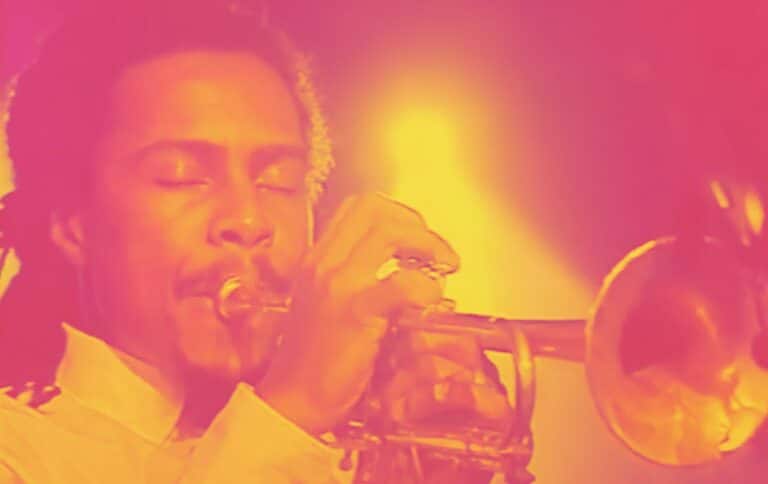When you start to transcribe and discover what your musical heroes are doing, you begin to open up a whole new understanding about how to improvise and approach chord changes. But then the problem soon becomes, how do you take this understanding and put it into your musical practice?
In other words, transcribing is great and all, but if you can’t apply the things you’re finding, then what use is it?
How do you get beyond an intellectual understanding of how to play jazz and turn your knowledge into an intuitive skill set that you can utilize in real-time?
After years of practicing improvisation, I’ve found no better way to do this than to deeply study jazz language.
And I like to think of jazz language like this…
You take small melodic bites from your favorite players and work on them in all keys. Gradually you accumulate more and more of these melodic bites for all the basic chord types that you encounter.
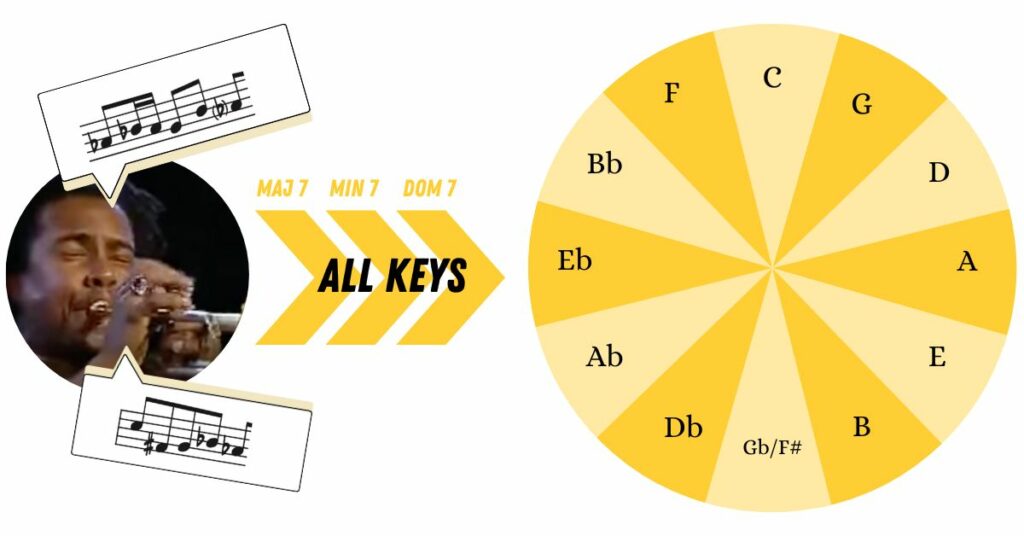
Over time, what you end up with is a plethora of kickstarter ideas…a basic vocabulary that you have available to you all the time for any chord symbol that you see or hear.
So for example, if you see an F minor symbol in a chord chart or hear an F minor chord, you’ll have more than just a scale, arpeggio, or some abstract theory concept to draw from….
You’ll have some simple ideas that your fingers and brain can easily build on in the moment to create new and interesting melodic ideas in real-time, and that’s what jazz language really is.

So today, we’re going to build up your jazz language by studying the language of the great Roy Hargrove, but rather than tackling his entire jazz vocabulary, we’ll zoom in on one specific chord type – minor chords.
By selecting one of your favorite players and a single chord type to study, you’ll quickly develop your vocabulary over a particular sound and add it to your knowledge base in an accessible way.
As you’ll soon see, this pick-a-player-and-chord-type tactic is a great strategy to use in the practice room that will allow you to easily focus your practice time and improve fast…
Roy Hargrove’s Minor Language: What is This Thing Called Love
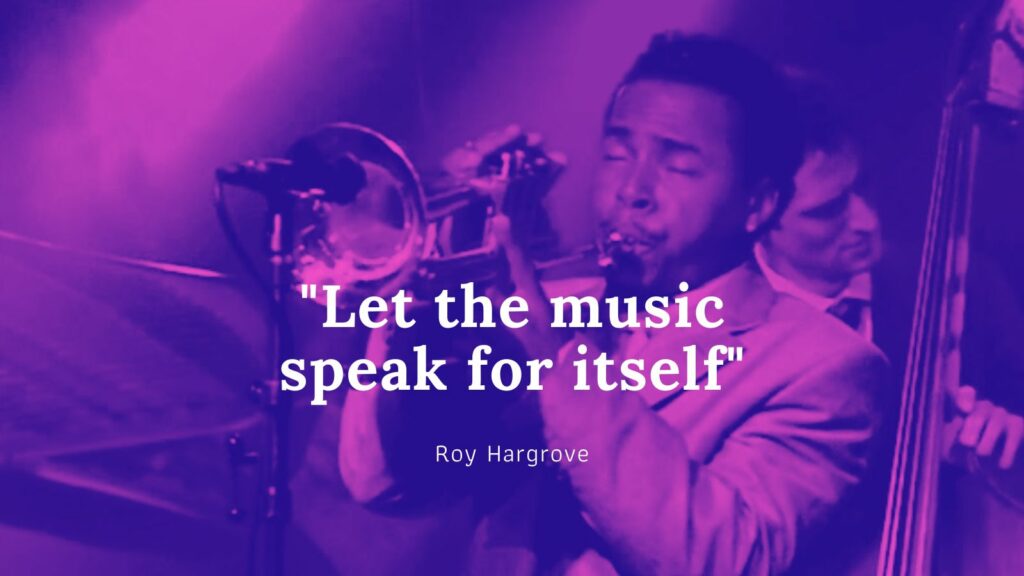
Roy Hargrove was one of my favorite musicians to ever live…
Having the opportunity to see him perform live several times, I witnessed his greatness first-hand…his energy, vibe, and true surrender to the moment were like nothing I’ve ever seen or heard before.
But under his mystery and larger than life musical voice lies an effortless command of jazz language: simple melodic bites over each chord that he’s meticulously gathered over the years.
And that’s the focus of today – these little pieces of minor jazz language that he uses on his solo over the classic standard What Is This Thing Called Love.
The process in today’s lesson will be very easy to follow…
- We’ll first transcribe a minor line for you – Every line we’ll look at will be over F minor making it easy to compare and contrast our findings
- Then we’ll break it down into the several pieces – We’ll aim to make 1 bar pieces from the larger line so that we can practice the language more easily
- And finally, we’ll give you Practice Exercises – These exercises will be progressive and help you master the line by addressing each piece
By understanding how each line is constructed and working on each exercise, your minor language vocabulary will easily grow ten fold in the upcoming weeks.
And with all this language, your understanding of how to improvise over minor chords will be clearer than it’s ever been before.
Let’s get started with the first Roy Hargrove exercise…
Roy Hargrove Minor Exercise #1

For each exercise, we’ll start with a transcribed line from the A Section of What Is This Thing Called Love, a minor ii V i i in the key of F minor…and we’ll be looking at what he plays specifically over the F minor part.

So for this first exercise, have a listen to Roy play this line over this place in the changes…

Can you hear how over the first part of the F minor chord he somehow creates an interesting rhythmic effect by shifting the stress to the upbeats?

Well, he does this by using the popular musical device known as enclosure…he encloses a chord tone with surrounding tones.
But he doesn’t use enclosure here in the simplest way…
In this particular case, he encloses the 9th (G) with the 3rd (Ab) and the b9/b2 (Gb) on the upbeat instead of the downbeat.
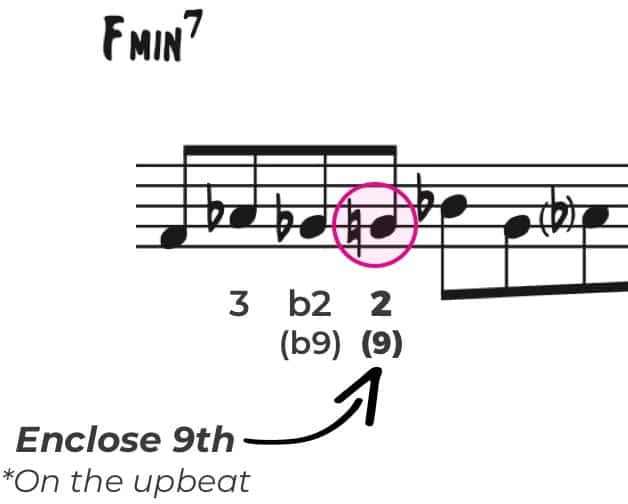
And this is what causes the interesting effect with the time – enclosing a note that lands on the upbeat (the and of 2 in the example) instead of the downbeat, which is much more common.
He then continues the first part of the line with an enclosure of the 3rd, landing on the downbeat of 4…
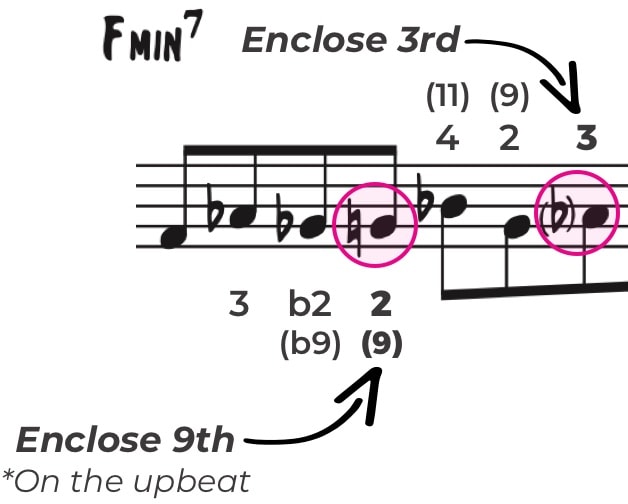
So taking this and creating an exercise from it, we’ll make the last note a quarter note to create one measure of material and then we’ll play it in all keys around The Circle of Fifths, or what we commonly refer to as The Cycle.
By isolating each bar of a larger line like this, you’ll quickly gain mastery over each piece of the line and learn it on a much deeper level than if you just played the entire original line in all keys.
So go ahead now and take this through all 12 keys…
Exercise 1A

Playing ideas around The Cycle like this is extremely valuable, but if you’re already banging your head against the wall trying to take this idea through all keys, we’ve got something that will help…
Simply show your love for Jazzadvice and Become a Premium Member.

By joining Premium, you’ll instantly gain access to a downloadable PDF with all 3 exercises that you’re going to learn today written out in all keys.
And you’ll get 3 additional exercises from today’s lesson written out in all keys for you, of course.
Not to mention, you’ll also get immediate access to all the other great exclusive lessons that Premium has to offer.
Okay for the second part of this exercise, we’ll take a look at what Roy plays in the second bar of F minor here…

As you can see, in this piece, he again uses enclosure, but instead of enclosing the 9th or the 3rd, he encloses the root with the major 7th and the 9th.

So for your next minor language exercise, you’ll take this bar through all keys…
Exercise 1B

Once you’ve gained fluidity with Exercises 1A and 1B, you’ll have two solid kick-starter minor ideas taken directly from a world class jazz musician!
Don’t underestimate the power of accumulating these powerful ideas and practicing them diligently.
Remember, reading through this lesson is not enough…Nor is practicing through the exercises just once.
Take these exercises to your practice room and drill them for a week. Then you’ll start to understand just how valuable learning jazz language really is.
Roy Hargrove Minor Exercise #2

For this second exercise, we’ll start with this line…

And we’ll zoom in on this bar where Roy uses beautiful leaps within his minor line that are a quintessential part of the Bebop Style.

Now the first thing to notice is that he approaches the 9th of the chord from a half step below…
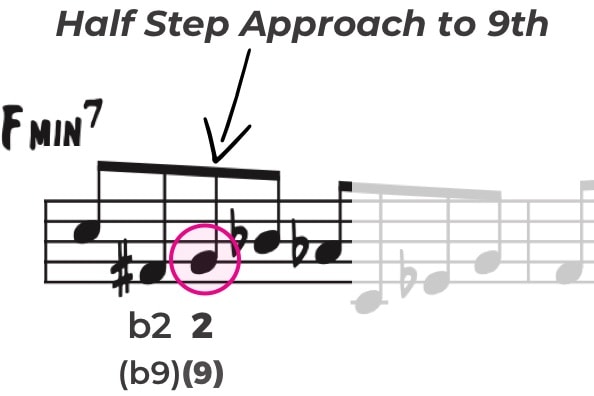
And then this 9th that he scoops up to is paired with the 11th (the 4th ) to enclose the 3rd…

So once you wrap your head around how Roy jumps down from the 5th of the chord to the 9th via an approach note from below, and how he continues to enclose the 3rd from there, take this first part of the measure and create a single measure exercise around The Cycle…
Again, the idea of breaking up a longer line, even a single measure, into smaller more manageable pieces is invaluable in developing fluidity and improvisational freedom with the information.
As we did before, we’ll adjust the note values to create a single measure of material to practice from the original 2 beats of language…
Exercise 2A

As you practice an exercise, always keep the points in mind that we touched on about how the line is constructed – these are the exact tips that will help you take it through all keys more easily.
And, make sure to keep the chord in mind that you’re playing over at any given moment. This is very important!
Your goal is to connect each bit of jazz language with the chord symbol and your fingers, so you have to stay aware of the chord you’re playing over as you practice…
Once you get a handle on this exercise, go ahead and isolate the second part where Roy uses the minor shape 3-5-7-2 resolving to 1, where the 7th and 9th (2nd) enclose the root of the chord.
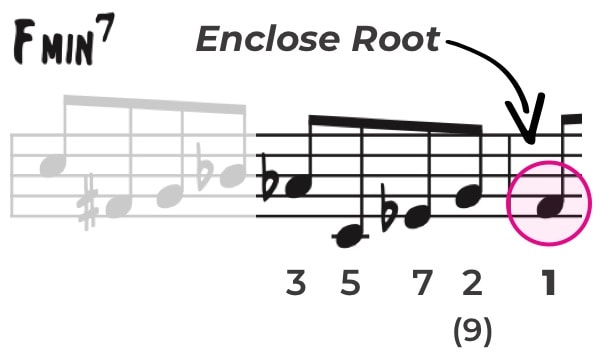
And take this through all keys, creating another single measure exercise around The Cycle from it…
Exercise 2B

Now, after practicing Exercises 2A & 2B, you’re now ready to put them together and tackle the entire minor piece of language.
But make sure you don’t skip straight to this without practicing both individual pieces first…
You see, even if you can play the entire larger idea in all keys, if you don’t spend the necessary time with each of the smaller pieces, you’ll never gain the flexibility with the line to be able to use it in a creative way.
So take your time and go through each smaller exercise before combining the exercises, as you’ll do now…
Exercise 2C
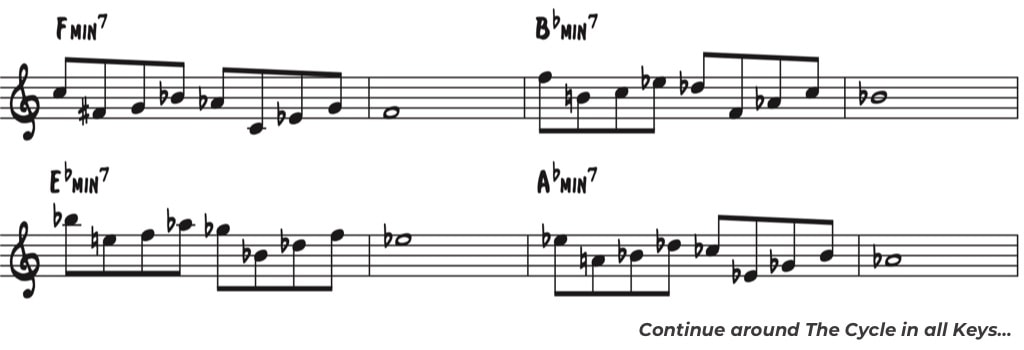
Alright, at this point you’ve worked on two different exercises, each containing multiple valuable pieces of minor language.
Now we’ll get into the third exercise…
Roy Hargrove Minor Exercise #3

For this 3rd exercise, have a listen to this line that Roy plays over the A section on What is This Thing Called Love…

And focus your attention on this bar of F minor…

Can you hear what makes the first two beats so interesting? He starts on the 3rd of the chord, Ab, and then encloses the 3rd to return to it again on beat 3.
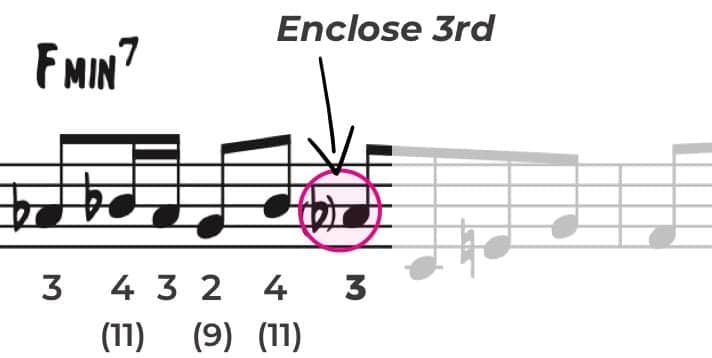
This quick return right back to the 3rd is a great little melodic piece to have under your belt, so in this next exercise, we’ll take these two beats and make a measure for you practice around The Cycle.
Exercise 3A

Now, once you get a handle on this exercise, take a look at the second part of the measure where Roy jumps down to the 5th from the 3rd, and then ascends up the major 7th and 9th to enclose the root.
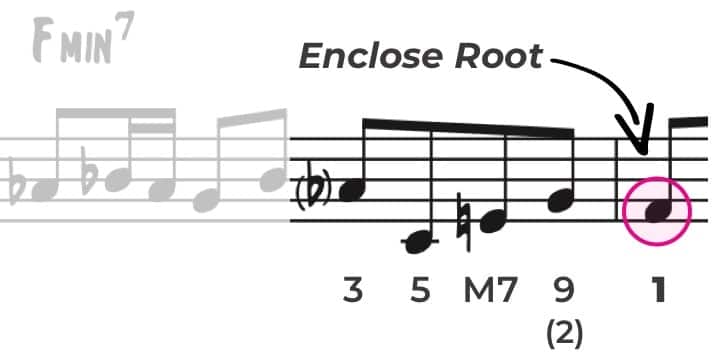
This piece of jazz language you’ll find in all the solos from the classic bebop players like Charlie Parker and Dizzy Gillespie, so make sure to get a handle on this little melodic gem by practicing the next exercise…
Exercise 3B

And finally, after you can confidently play Exercises 3A & 3B, combine them to create the next exercise.
Exercise 3C

Okay, now that you have worked through 3 full exercises, you should have quite a bit of minor language at your disposal, so next I want to share with you how you can start mixing and matching the things you’ve worked on to create even more practice exercises…
how combination works as you amass language

For jazz language, combination is king
The more language you acquire, the more potential combinations will exist within your vocabulary.
You see, as you improvise, you naturally work your way into different areas of a chord. And when you have several different options of where to go from anywhere you end up, you can really start to be creative.
For example, let’s take the piece of language from Exercise 2A…and the piece from Exercise 3A…and then combine them into a new one measure exercise, like this…
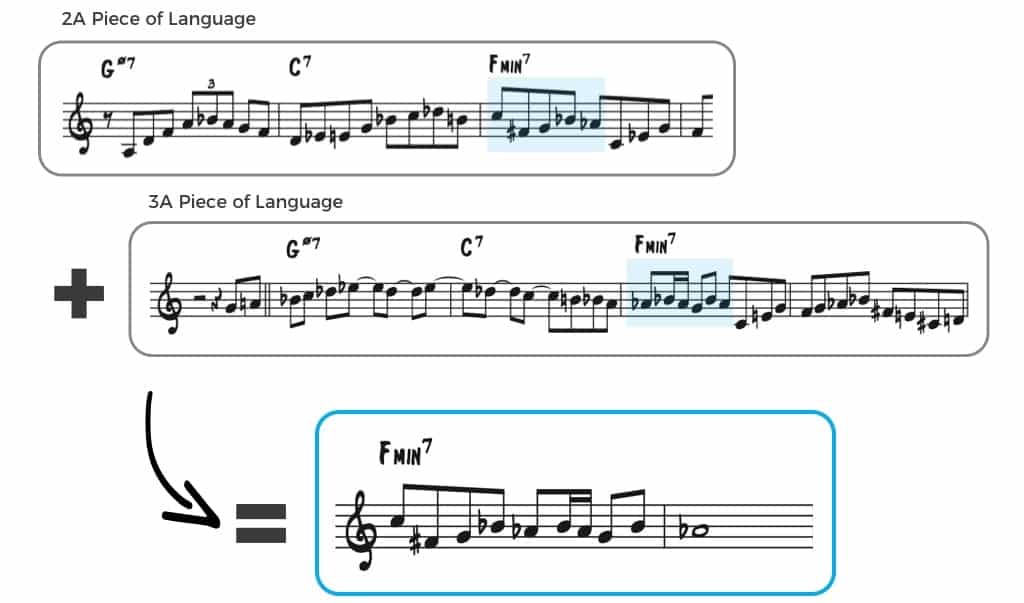
Or perhaps we take the piece from 3B and pair it with 1A to create a two measure exercise…
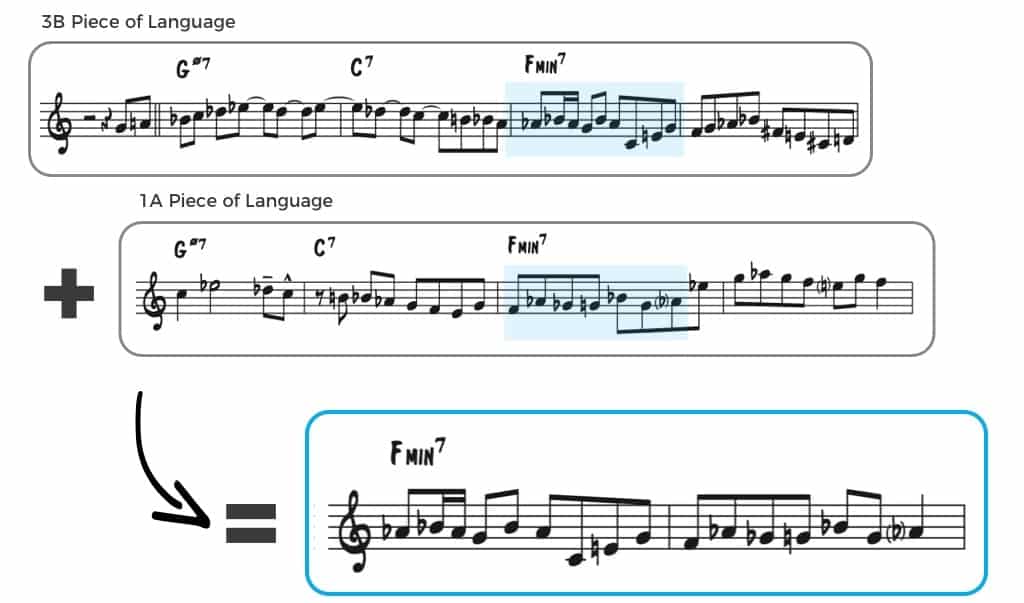
The more ideas you transcribe or discover, the more exercises you can make…
But here’s where things get interesting…as you amass more and more little pieces like this, your brain will start to combine things in new ways without having to predetermine anything.
When you truly start to acquire a few pieces of language, this is where you’ll start to bridge the gap between using language as an exercise and using it in an improvisational way
But, to get to this point, you need to get multiple pieces of language under your belt, and you need to drill the language until it becomes second nature to you, so you don’t have to think about it.
Gradually, by practicing in this fashion, you’ll be able to move away from exercises that you predetermine and instead, use each piece of language that you’ve acquired in new contexts, variations, and combinations by simply improvising.
Minor Exercises 4, 5, & 6
Okay, now that you’ve got some of the basics down with minor language, we’ll get into 3 more exercises that will expose you to some more powerful concepts and techniques…
In these next 3 Exercises, we’ll cover…
- One of my favorite minor language shapes
- More variations to easily enclose the 3rd and the root
- How Roy uses minor language over the bar line
But these additional exercises are for Premium Members only. (Already Premium? Log In Here)
So if you want to grow your jazz improvisation knowledge and keep Jazzadvice alive in the process, go ahead and Join Premium Now.

As a Premium Member, you’ll get:
- A Downloadable PDF of the first 3 exercises
- 3 Additional exercises, again written out for you in all keys
- Access to a ton more Premium Lessons & Resources
Click Here to Learn More About Premium and unlock the rest of this lesson…
Your Minor LANGUAGE Journey
When you start down this road toward getting a foundation in minor language, you’re bound to have some frustration…
Transcribing lines you like is not always easy. And even once you do, taking a piece and practicing it in all keys is quite challenging to say the least.
So take your time with it and realize that each new piece of language that you work on will move you closer to gaining fluidity over a chord sound.
As you go about this process in your own practice, remember all the things we worked on today…
- Learn to take larger lines and break them up into smaller pieces
- Practice each of these pieces before combining them
- Understand how a line is put together to take it through all keys
- Always keep the chord you’re playing over in your mind
- Use the power of combination as you amass more language
The process of learning language never stops…
But the important thing is to get started! With today’s exercises and the additional exercises you can gain access to as a Premium Member, you’ll be playing over minor chords in a whole new way in no time!
